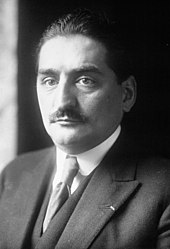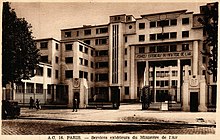Ministère de l'Air
The Ministère de l'Air was the Aviation Ministry of France . It existed intermittently from 1928 to 1947 and was responsible for both civil aviation and military aviation .
prehistory
The first ministry to take on tasks in the field of (civil) aviation in France was the Ministry of Construction (Ministère des Travaux publics) from 1909 . It granted subsidies for the development of aviation, reserved a contingent of awards in the Legion of Honor for aviation and aviation pioneers, and set up a commission to evaluate problems associated with aviation. In 1910 it expanded the competencies of the Direction des Mines to include aviation and in 1911 published a regulation regulating the same.
In 1919, Georges Clemenceau , then French Prime Minister, set up a body for the coordination of civil and military aviation, the Organizme de coordination générale de l'Aéronautique (OCGAé) , in the War Ministry, which he also headed . In 1920 responsibility for civil aviation was attached to the Ministry of Construction, while the Ministry of War kept military aviation under its responsibility. A State Secretariat for Air Transport and Air Transport was established; the politician Pierre-Étienne Flandin was appointed State Secretary ( Sous-secrétaire d'État ) . Flandin, who himself had obtained a pilot's license in 1912 , was an advocate of an air force as an independent branch of the armed forces , which was not created until 1934. Despite limited human resources, his authority issued some pioneering decrees and ordinances to regulate air traffic and the licensing of flight personnel. In November 1920, the state weather service Office national météorologique , forerunner of Météo-France , was subordinated to the authority. Flandin succeeded Laurent Eynac in 1921 .
In 1926 the State Secretariat was dissolved after a dispute over competencies with the Ministries for Defense and Colonies. Its duties were entrusted to the Ministry of Commerce, Industry and Postal Services, under whose supervision a General Directorate for Aviation and Air Transport ( Direction générale de l'Aéronautique et des Transports aériens ) was established.
Establishment of the Aviation Ministry from 1928 until the end of the Third Republic
After the French trade minister Maurice Bokanowski was killed in a plane crash on September 2, 1928 and the government was heavily criticized by the press for the desolate state of the French aviation industry, the government under Raymond Poincaré decided three days later to create an aviation ministry which was implemented by decree of September 14, 1928.
The first aviation minister was Laurent Eynac , who had already headed the relevant state secretariat in the building ministry. The responsibilities of his authority extended to all areas of aviation, i. H. Military, naval, colonial and civil aviation, which until then had been divided between four ministries. Laurent Eynac was followed by Paul Painlevé (December 1930) and Jacques-Louis Dumesnil (January 1931) as ministers . However, the grouping of responsibilities for aviation in a single ministry remained so controversial that the ministry was dissolved in February 1932. Its tasks were divided between the Ministry of Construction and Merchant Shipping and the Ministry of Defense. But it was set up again in June of the same year, again with Painlevé at the helm. He was followed by Pierre Cot in January 1933 .
After its founding, the seat of the Ministry was the building of a former private school in the 16th arrondissement of Paris at 35 rue Saint-Didier , which the state acquired in December 1928. But it turned out to be too small from the start. From 1930 new buildings were erected in the 15th arrondissement on Boulevard Victor at the level of the Porte d'Issy ; the complex was called the Cité de l'Air . It was initially intended to complement the headquarters on Rue Saint-Didier , but eventually Minister Pierre Cot decided to leave it entirely and move the entire Ministry to Boulevard Victor , which happened on February 12, 1934.
By law of June 30, 1933, the responsibilities of Cots Ministry were determined in the areas of armed forces, flight material, flight routes, airports, air traffic and airspace control, weather service and information transmission. The milestones of his first tenure as aviation minister include the establishment of the national airline Air France on August 31, 1933 and the creation of the air force as an independent branch of the armed forces. On January 15, 1934, the director general for civil aviation, Emmanuel Chaumié , was killed in an airplane accident in which the deputy director general of Air France, Maurice Noguès, also died.
Cot was replaced by General Victor Denain after the cabinet resigned in February 1934 ; This was followed in January 1936 by Marcel Déat . With the assumption of government responsibility by the left-wing alliance Front populaire (“Popular Front”), Pierre Cot was again Minister of Aviation in Léon Blum's first cabinet in June 1936 . In his second phase as Minister of Aviation from 1936 to 1938, Cot promoted the nationalization of the aviation industry. In addition, with the knowledge of Prime Minister Blum and with the help of the Treasury Department headed by Vincent Auriol , he had aircraft sent as military aid to the republican forces in the Spanish civil war , which was a violation of the official standstill policy of France.
In January 1938, Guy La Chambre took over the ministry from Pierre Cot. At the outbreak of the Second World War belonged to the ministry
- the General Staff of the Air Force,
- the civil service personnel,
- the directorate for military personnel,
- the auditing, budget and legal affairs directorate,
- the Directorate for Civil Aviation,
- the technical-industrial directorate,
- the Directorate for Military Aircraft,
- the Directorate for Construction and Infrastructure,
- the state weather service.
In March 1940, La Chambre was replaced as Minister by Laurent Eynac, who was only briefly in office; he was followed in June 1940 by General Bertrand Pujo in the government of Philippe Pétain , the last of the Third Republic .
Vichy regime
After the Armistice of Compiègne of June 22, 1940 and the German occupation of France , the National Assembly authorized Pétain on July 10, 1940 to establish a new state structure, which resulted in the Vichy regime . The previous Ministry of Aviation was converted a few days later, by law of July 12, 1940, into a Secrétariat d'État à l'Aviation ("State Secretariat for Aviation"). Just like the state secretariats for war and for the navy created at the same time from the previous corresponding ministries, it came under the umbrella of the Ministère de la Défense nationale . Pujo, Minister of Aviation since June 1940, remained at the head of the new State Secretariat for a short time; he was followed by four other generals in office until August 1944. The secretariat was based in Vichy; a branch in Paris was entrusted with matters relating to the zone occupied by Germany. With the armistice, the Ministry's military activities had practically come to a standstill. After the whole of France was occupied by the German Wehrmacht in November 1942, the authority's military staff were released and the General Staff of the Air Force was disbanded. The air force was disbanded on November 27, 1942 and French agencies were banned from any flight operations. On March 26, 1943 the authority was merged with the Secrétariat d'État à la Guerre and renamed the Secrétariat général à la Défense aérienne ("General Secretariat for Air Defense").
After the liberation
The Provisional Government of the French Republic, made up of communists, socialists, radical socialists and Gaullists, declared all acts of the Vichy regime null and void by decree of August 9, 1944. This also applied to the restructuring of the aviation authorities by Pétain's regime, so that the Ministère de l'Air de iure never ceased to exist between 1940 and 1944. After the liberation of Paris at the end of August 1944, de Gaulle declared Charles Tillon as Minister of Aviation in his first cabinet on September 10th . In the second de Gaulle cabinet on November 13, 1945, however, there was no longer an aviation minister. By decree of December 22, 1945, responsibility for civil aviation was assigned to the Ministry of Construction and Transport under Jules Moch , the corresponding department was designated by Max Hymans as Secrétaire général à l'Aviation civile et commerciale ("General Secretary for Civil and Commercial Aviation ") directed. In the first government of the Fourth Republic , the cabinet of Paul Ramadier , there was another aviation ministry for a short time, namely from January 12 to October 21, 1947, with André Maroselli as minister; however, Hymans' authority, which remained part of the Ministry of Transport during this period, retained its responsibilities. Then the era of an independent aviation ministry in France was over.
List of aviation ministers
- "First" Ministry of Aviation (September 1928 to February 1932)
- Laurent Eynac (September 1928 to December 1930)
- Paul Painlevé (December 1930 to January 1931)
- Jacques-Louis Dumesnil (January 1931 to February 1932)
- "Second" Aviation Ministry (June 1932 to 1940)
- Paul Painlevé (June 1932 to January 1933)
- Pierre Cot (January 1933 to February 1934)
- Victor Denain (February 1934 to January 1936)
- Marcel Déat (January to June 1936)
- Pierre Cot (June 1936 to January 1938)
- Guy La Chambre (January 1938 to March 1940)
- Laurent Eynac (March to June 1940)
- Bertrand Pujo (June to July 1940)
- State Secretariat for Aviation and General Secretariat for Air Defense (July 1940 to August 1944)
- Bertrand Pujo (July 12 to September 6, 1940)
- Jean Bergeret (September 6, 1940 to April 19, 1942)
- Jean-François Jannekeyn (April 19, 1942 to April 4, 1943)
- Paul Gastin (April 4, 1943 to April 30, 1944)
- Paul Moniot (April 30 to August 26, 1944)
- "Third" Aviation Ministry (1945, 1947)
- Charles Tillon (September 10 to November 13, 1945)
- André Maroselli (January 12 to October 21, 1947)
Individual evidence
- ↑ a b c d e f g h i Pierre Lauroua: L'aviation civile - une administration dans Paris - 1919–2009 . Mission Mémoire de l'aviation civile, 2012, ISBN 978-2-11-129156-0 (French, full text on aviation-civile.gouv.fr ).
- ↑ Emmanuel Pénicaut: Un ministère de quête d'identité? Une histoire du ministère de la Defense par ses bâtiments, des années trente à nos jours . In: In Situ - Revue des patrimoines . tape 34/2018 , April 27, 2018, doi : 10.4000 / insitu.15864 (French, full text on openedition.org ).
- ^ Sabine Jansen: COT Pierre. In: Le Maitron - Dictionnaire biographique du mouvement ouvrier (Online). Éditions de l'Atelier, March 22, 2019, accessed on March 10, 2020 (French).
- ^ Charles-Louis Foulon: COT Pierre (1895-1977). In: Encyclopædia Universalis (online). Retrieved March 10, 2020 (French).
- ↑ a b Philippe Valode: Le destin des hommes de Pétain . Nouveau Monde, Paris 2014, ISBN 2-36583-989-4 (French, limited preview in Google Book Search).
Coordinates: 48 ° 50 ′ 2.9 " N , 2 ° 16 ′ 56.9" E



